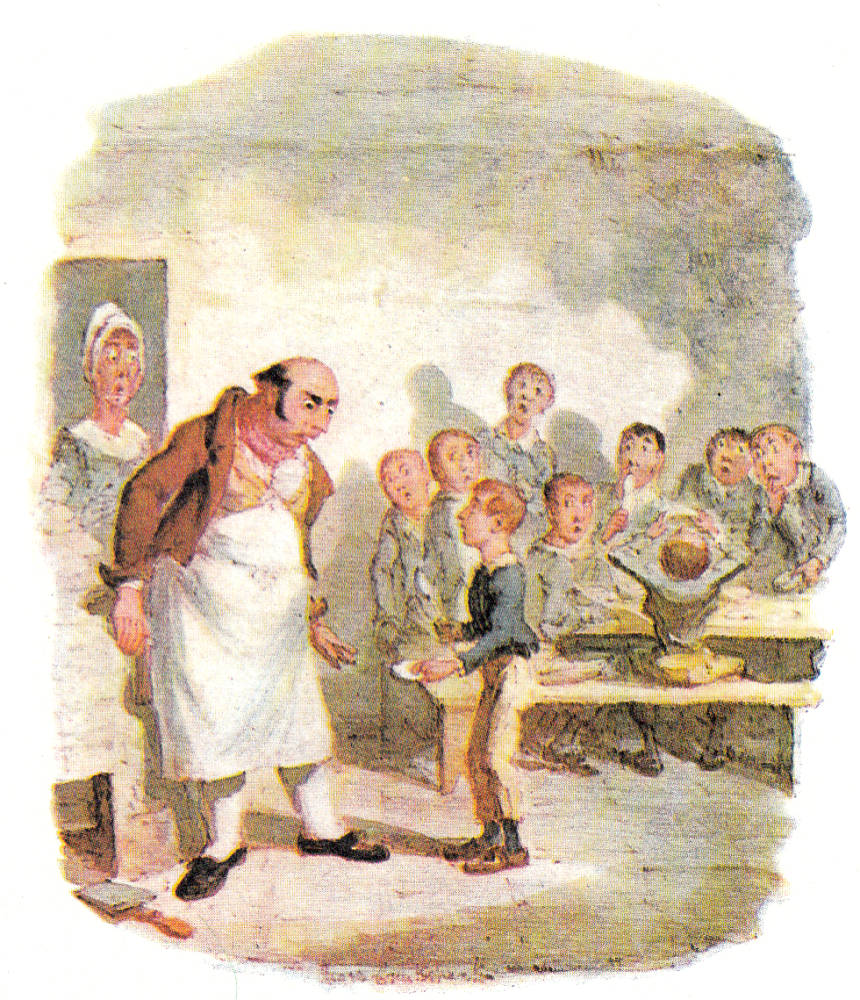

Oliver Twist by J. Clayton Clarke ("Kyd") for the 1910 watercolour series: reproduced on John Player cigarette card no. 4: Ninety-two Characters from Dickens: The Adventures of Oliver Twist. 2 ½ inches high by 1 ¼ inches wide (6.3 cm high by 3.3 cm wide). [Click on the images to enlarge them.]
Passage Illustrated: Asking for More, or, Oliver as the Boys' Stalking Horse
The evening arrived; the boys took their places. The master, in his cook's uniform, stationed himself at the copper; his pauper assistants ranged themselves behind him; the gruel was served out; and a long grace was said over the short commons. The gruel disappeared; the boys whispered each other, and winked at Oliver; while his next neighbours nudged him. Child as he was, he was desperate with hunger, and reckless with misery. He rose from the table; and advancing to the master, basin and spoon in hand, said: somewhat alarmed at his own temerity:
"Please, sir, I want some more."
The master was a fat, healthy man; but he turned very pale. He gazed in stupified astonishment on the small rebel for some seconds, and then clung for support to the copper. The assistants were paralysed with wonder; the boys with fear.
"What!" said the master at length, in a faint voice.
"Please, sir," replied Oliver, "I want some more." [Chapter II, "Treats of Oliver Twist's Growth, Education, and Board," pp. 9-10]
Commentary: Characters from Dickens
Of the set of 50 cigarette cards, initially produced in 1910 and reissued in 1923, fully 15 or 30% concern a single novel, The Pickwick Papers, and another five Oliver Twist. That forty per cent of the illustrations concern these early novels attests to the continued popularity of the picaresque comic novels — and also suggests that the later, darker novels such as Our Mutual Friend and The Mystery of Edwin Drood offered little for the caricaturist, the only late characters in the series being the singularly unpleasant Silas Wegg and Rogue Riderhood from Our Mutual Friend, and Turveydrop, Jo, Bucket, and Chadband from Bleak House. The popular taste was clearly still towards the earlier farce, robust satire, and pointed character comedy of the early Dickens.
Kyd's representations are largely based on the original illustrations by Phiz and Seymour, although the modelling of the figures is suggestive of Phiz's own, expanded series for Household Edition volume of the 1870s. The anomaly, of course, is that Kyd should elect to depict minor figures from the first Dickens novel such as the Dingley Dell cricketers Dumkins and Luffey and the minor antagonist Major Bagstock, but omit significant characters from such later, still-much-read novels as A Tale of Two Cities and Great Expectations. Five of the fifty or 10% of the series come from the cast of The Adventures of Oliver Twist; or, The Parish Boy's Progress (1837-39): Oliver himself, asking for more; Fagin with his toasting fork, from the scene in which he prepares dinner for his crew; Sikes holding a beer-mug, and the Artful Dodger in an oversized adult topcoat and crushed top-hat. Surprisingly, some of the other significant characters, including Nancy and Rose Maylie, are not among the first set of fifty characters, in which Kyd exhibits a strong male bias, as he realizes only seven female characters: only the beloved Nell, the abrasive Sally Brass, and the quirky Marchioness from The Old Curiosity Shop, Sairey Gamp from Martin Chuzzlewit, Aunt Betsey Trotwood from David Copperfield, the burly Mrs. McStinger from Dombey and Son, and the awkward Fanny Squeers from Nicholas Nickleby appear in the essentially comic cavalcade. Clearly the popular taste in "characters from Dickens" as well as in "novels from Dickens" has changed markedly over the past century.
Illustrations from the Serial (1837), Diamond Edition (1867), Household Edition (1871), Player's Cigarette Cards, and the Waverley Edition (1912)


Left: Cruikshank's original version of Oliver's Asking for More (1837, 1846). Right: Eytinge's Oliver and Little Dick (1867).



Left: Charles Pears' early 20th c. revision, focussing on the two contrasting figures, Oliver Twist and the Master of the Workhouse. Centre and right: Harry Furniss's : Starvation in the Workhouse (1910) and Clayton J. Clarke'sOliver Twist, a watercolour in The Characters of Charles Dickens (c. 1900).

Above: Mahoney's 1871 engraving of the gaunt Oliver's acting as a spokesperson for his fellow starving inmates, Uncaptioned Headpiece for Chapter One; although the famous incident actually occurs in the second chapter, the Household Edition uses it as a keynote.
Related Material
- Oliver Twist as a Triple-Decker
- Oliver untainted by evil
- Like Martin Chuzzlewit, it agitates for social reform
- Oliver Twist Illustrated, 1837-1910
Scanned images and text by Philip V. Allingham. [You may use these images without prior permission for any scholarly or educational purpose as long as you (1) credit the person who scanned the images and (2) link your document to this URL in a web document or cite the Victorian Web in a print one.]
Bibliography
Dickens, Charles. The Adventures of Oliver Twist; or, The Parish Boy's Progress. Illustrated by George Cruikshank. London: Chapman & Hall: 1846.
Dickens, Charles. The Adventures of Oliver Twist. Frontispieces by Felix Octavius Carr Darley and Sir John Gilbert. The Household Edition. 55 vols. New York: Sheldon & Co., 1861. 2 vols.
Dickens, Charles. The Adventures of Oliver Twist. Illustrated by Sol Eytinge, Jr. The Diamond Edition. 14 vols. Boston: Ticknor & Fields, 1867. Vol. XI.
Dickens, Charles. The Adventures of Oliver Twist. Illustrated by James Mahoney. The Household Edition. 22 vols. London: Chapman and Hall, 1871. Vol. I.
Dickens, Charles. Oliver Twist. Illustrated by Harry Furniss. The Charles Dickens Library Edition. 18 vols. London: Educational Book, 1910. Vol. III.
Hammerton, J. A. "Chapter 11: Oliver Twist." The Dickens Picture-Book. The Charles Dickens Library Edition. Illustrated by Harry Furniss. 18 vols. London: Educational Book Co., 1910. Vol. 17. Pp. 129-146.
Created 4 January 2015
Last modified 2 July 2025